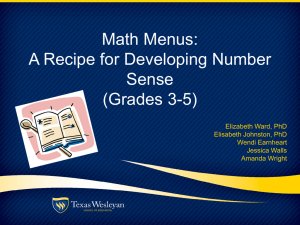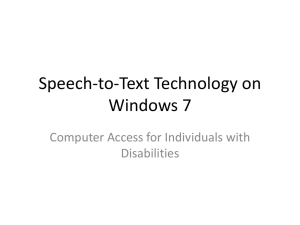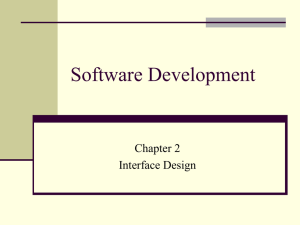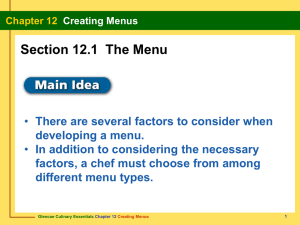Differentiate to Motivate! - ebrprofessionaldevelopmentportal
advertisement
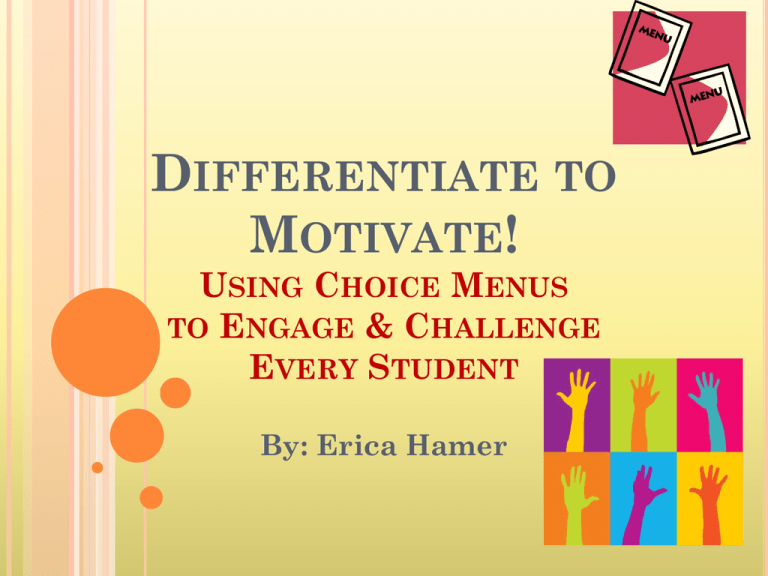
DIFFERENTIATE TO MOTIVATE! USING CHOICE MENUS TO ENGAGE & CHALLENGE EVERY STUDENT By: Erica Hamer WHY USE ACTIVITY MENUS? Choice Engagement Motivation Hands-On Student-Centered Individual Needs Learning Styles Independence Interests Differentiation Build Upon Readiness Strengths Challenge HOW HAVE YOU USED ACTIVITY MENUS IN YOUR CLASSROOM? What format did you use for your activity menus? What did you like best about using activity menus in your classroom? What were some obstacles that you encountered using activity menus? 5 MENU TYPES Tic-Tac-Toe Menu List Menu 2-5-8 (or 20-50-80) Menu Game Show Menu Baseball Menu Each menu type has different benefits, limitations, & time considerations TIC-TAC-TOE MENU Description: Benefits: 8 Predetermined choices + 1 free choice All choices at same level of Bloom’s, carry same weight for grading, & require similar time/effort Flexibility to either cover 1 topic in depth or 3 different objectives by completing 1 activity in each row or column Student-friendly & easy to understand Easy to grade Limitations: Only covers 1 or 3 topics Student choice limited to tic-tac-toe pattern Time Considerations: Short time period of 1-3 weeks LIST MENU OR CHALLENGE LIST Description: 10 Predetermined choices + 1 free choice Points per choice are based on level of Bloom’s Choices require differing amounts of time/effort Benefits: Students like having control over their grades & the ability to make up lost points by completing another choice In-depth study Higher & lower level activities for differing readiness levels Limitations: Only covers 1-3 topics If 3 topics, objectives limited to individual student choices Heavy teacher preparation of materials Time Considerations: 2 weeks maximum 2-5-8 (OR 20-50-80) MENU Description: 8 Predetermined choices to total 10 (or 100) points Point values of 2 (or 20), 5 (or 50), or 8 (or 80) based on level of Bloom’s Choices require differing amounts of time/effort Benefits: Students like having control over their grades Students must complete at least 1 activity at a higher level of Bloom’s Limitations: Only 1 topic, in depth No free choice Students complete only 1 higher level activity Time Considerations: 1 week maximum BASEBALL MENU Description: 20 Predetermined choices 4 different point values based on level of Bloom’s: singles, doubles, triples, & home runs Students must complete __ # runs around all 4 bases for 100% Choices require differing amounts of time/effort Benefits: Students like having control over their grades Flexibility of many choices at each level Baseball theme can be used on bulletin board where students move themselves through each base as a visual reinforcer Limitations: Only 1 topic, many objectives, in-depth 1 free choice Heavy teacher preparation of materials & student work space Time Considerations: Longer period of time: 4-5 weeks GAME SHOW MENU Description: 3 predetermined choices + 1 free choice per topic/objective Point values based on level of Bloom’s Choices require differing amounts of time/effort Students complete 1 activity per objective & set point criteria Benefits: Students like having control over their grades Flexibility of many choices at each level & students can propose their own activity idea for each objective Individualized contracts for different learning levels Students must complete 1 activity for each objective Limitations: Students & parents must understand guidelines Time Considerations: Longer period of time: 4-6 weeks VARIATIONS Adjust any menu to fit the learning needs of your students, your weekly schedule, & your grading requirements Create menus for different levels & assign based upon unit pre-test data to ensure advanced students are adequately challenged & struggling students are remediated without becoming frustrated Break down amount of time allowed to complete activities into days/hours to help students manage their work time DIFFERENTIATION: CHALLENGE WITHOUT FRUSTRATION OR BOREDOM All students should NOT be required to do same activities because all students are NEITHER on the same level, NOR do they have the same learning style No student should be required to do MORE or LESS activities, instead require DIFFERENT rows/menus by increasing/decreasing challenge level of activities Every student must be allowed to complete work at their OWN ability level- provide NO student activity choices too difficult or too easy for THEIR current level of understanding Provide remedial activity choices that struggling students can complete INDEPENDENTLY USE PRE-TEST DATA Determine specific learning goals of unit Design a brief pre-test to determine individual challenge level for each unit Pre-test at least 1 week before unit so you have time to use data to create appropriately leveled activities What are some possible pre-test data sources for specific skills that your school already uses? (Edusoft; Star-Math/Reading; KidBiz; Dibels; LEAP/iLEAP; Iowa; Tiers 1,2,3) DESIGNING ENGAGING ACTIVITIES List activities suggested in the curriculum Google unit focus for activity ideas from other teachers Explore Pinterest.com for hands-on activities & games that meet learning objectives Adapt activities in “extension” section of textbook chapter or teacher’s manual National Science Teachers Association (NSTA) & National Council of Teachers of Mathematics (NCTM) website lesson plan collections NationalGeographic.com Xpeditions activities Build ideas upon Product Criteria Cards APPROPRIATE RIGOR Adjust challenge level based upon your students’ readiness & depth of understanding of unit skills Increase rigor on activities for advanced students Decrease rigor for struggling students- activities should reinforce basic skills yet not mastered 3 Menu Rigor Levels: Below Grade Level- Remediation- Unsatisfactory or Approaching Basic- Bloom’s Remember or Understand On Grade Level- Basic- Bloom’s Apply or Analyze Above Grade Level- Acceleration- Mastery or Advanced- Bloom’s Evaluate or Create MAKE & TAKE: TIC-TAC-TOE MENU Specific Learning Goal- Informational Text: Range of Reading and Level of Text Complexity CCR Anchor Standard 10: Read and comprehend complex literary and informational texts independently and proficiently. Brainstorm activities for your grade/subject for a variety of learning styles & interests on sticky notes (see product criteria cards for ideas) Design increases & decreases in rigor according to your students’ readiness levels Rearrange activity sticky notes on Menu board(s) & decide on appropriate assignment pattern for your above/on/below-level students SOURCES ONLINE RESOURCES Choice Menu Examples & Templates PDF http://daretodifferentiate.wikispaces.com/Choice+Boards Choice Menus Templates & Activity Ideas http://www.pvusd.k12.ca.us/departments/GATE/choiceboar ds/MeaningfulMenus.pdf Dinner Learning Menu: Appetizer, Entrée, & Dessert http://differentiationkit.wikispaces.com/Dinner+Menus 5 Minute Video for Teacher: Using Dinner Learning Menu https://www.teachingchannel.org/videos/differentiatinginstruction-strategy Differentiated Assessment Article: Motivation & Engagement with Homework Menus http://whatworks.wholechildeducation.org/blog/fromdifferentiated-instruction-to-differentiated-assessment/ Differentiated Instruction Handouts http://www.k8accesscenter.org/online_community_area/Diff erentiatedInstructionHandouts.asp
